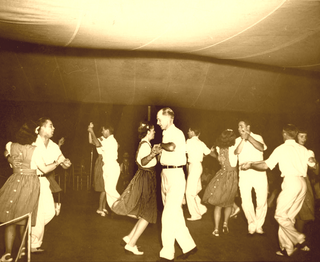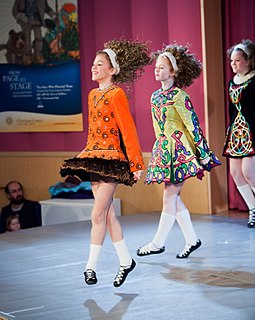
Contra dance is a folk dance made up of long lines of couples. It has mixed origins from English country dance, Scottish country dance, and French dance styles in the 17th century. Sometimes described as New England folk dance or Appalachian folk dance, contra dances can be found around the world, but are most common in the United States, Canada, and other Anglophone countries.

The reel is a folk dance type as well as the accompanying dance tune type. Of Scottish origin, reels are also an important part of the repertoire of the fiddle traditions of the British Isles and North America. In Scottish country dancing, the reel is one of the four traditional dances, the others being the jig, the strathspey and the waltz, and is also the name of a dance figure.

A country dance is any of a very large number of social dances of a type that originated in the British Isles; it is the repeated execution of a predefined sequence of figures, carefully designed to fit a fixed length of music, performed by a group of people, usually in couples, in one or more sets. The figures involve interaction with your partner and/or with other dancers, usually with a progression so that you dance with everyone in your set. It is common in modern times to have a "caller" who teaches the dance and then calls the figures as you dance.

A square dance is a dance for four couples arranged in a square, with one couple on each side, facing the middle of the square. Square dances contain elements from numerous traditional dances and were first documented in 16th-century England, but they were also quite common in France and throughout Europe. Early square dances, particularly English country dances and French quadrilles, traveled to North America with the European settlers and developed significantly there.

Irish dance is a group of traditional dance forms originating from Ireland, encompassing dancing both solo and in groups, and dancing for social, competitive, and performance purposes. Irish dance in its current form developed from various influences such as Native Irish dance, French quadrilles and English country dancing. Dance was taught by "travelling dance masters" across Ireland in the 17th-18th century, and separate dance forms developed according to regional practice and differing purposes. Irish dance became a significant part of Irish culture, particularly for Irish nationalist movements. From the early 20th century, a number of organisations promoted and codified the various forms of dance, creating competitive structures and standardised styles.

A cèilidh or céilí is a traditional Scottish or Irish social gathering. In its most basic form, it simply means a social visit. In contemporary usage, it usually involves dancing and playing Gaelic folk music, either at a house party or a larger concert at a social hall or other community gathering place.
The South Galway Set is a set dance that hails from the Gort area of Galway, Republic of Ireland. It can be viewed on Volume 2 of the video series The Magic of Irish Set Dancing with instruction by the late Connie Ryan. Other published instructions include Terry Moylan's Irish Dances, Pat Murphy's Toss the Feathers and Tom Quinn's Irish Dancing. Joe O'Hara has two online versions of this set: a 4-couple workshop version and a traditional half set version.
The Clare Lancers Set is one of the most popular dances in the Irish Set Dancing repertoire. As the name suggests it hails from the Clare area on the mid-west coast of the Republic of Ireland. Other published instructions for this dance include Larry Lynch's Set Dances of Ireland, Terry Moylan's Irish Dances, Pat Murphy's Toss the Feathers and Tom Quinn's Irish Dancing. Joe O'Hara and the Newcastle Irish Set Dancers have versions this set online.

The Irish flute is a conical-bore, simple-system wooden flute of the type favoured by classical flautists of the early 19th century, or to a flute of modern manufacture derived from this design. The majority of traditional Irish flute players use a wooden, simple-system flute.
Traditional square dance is a generic American term for any style of American square dance other than modern Western. The term can mean (1) any of the American regional styles that existed before around 1950, when modern Western style began to develop out of a blend of those regional styles, or (2) any style that has survived, or been revived, since around 1950.

Irish stepdance is a style of performance dance with its roots in traditional Irish dance. It is generally characterized by a stiff upper body and fast and precise movements of the feet. It can be performed solo or in groups. Aside from public dance performances, there are also stepdance competitions all over the world. These competitions are often called Feiseanna. In Irish dance culture, a Feis is a traditional Gaelic arts and culture festival. Costumes are considered important for stage presence in competition and performance Irish stepdance. In many cases, costumes are sold at high prices and can even be custom made. Males and females can both perform Irish stepdance but for the most part in today's society, the dance remains predominantly female. This means that the costumes are mainly dresses. Each dress is different, with varying colors and patterns, designed to attract the judge's eye in competitions and the audience's eye in performance. General appearance beside the costume is also equally important. Dancers would typically curl their hair before each competition. Many dancers invest in curled wigs that match their hair color. Poodle Socks are worn with the dresses and shoes. These are white socks that stretch to mid-calf with distinctive ribbing.

Irish traditional music is a genre of folk music that developed in Ireland.
Paddy Canny (1919–2008) was an Irish fiddle player. In a career that spanned over six decades, Canny was instrumental in popularizing Irish traditional music, both in Ireland and internationally. He gained initial fame in the late 1940s as a founding member of the Tulla Céilí Band, which made its first appearance on RTÉ Radio in 1948 and had positioned itself as the top céilí band in Ireland by the late 1950s. Canny captured the All Ireland fiddle championship in 1953 and was featured on the landmark 1959 recording, All-Ireland Champions: Violin. Although he stopped performing for large audiences in 1965, he returned briefly in the 1990s to record his critically acclaimed solo album, Paddy Canny: Traditional Music from the Legendary East Clare Fiddler.

Ceili dances, or true ceili dances are a popular form of folk dancing in Ireland. Ceili dances are based on heys, round dances, long dances, and quadrilles, generally revived during the Gaelic revival in the first quarter of the twentieth century and codified by the Irish Dancing Commission. These thirty dances form the basis for examination of Ceili dance teachers. Irish ceili is a participatory social event attended by both men and women and accompanied by live Irish traditional music.
Sean-nós dance in America has its roots in Irish culture, but may be practiced differently from how it is danced in Ireland. When Irish people emigrated to America in great numbers during the early American Colonial period, or when escaping The Troubles in Ireland, they brought their dance culture with them. One of the many forms of Irish dance is sean-nós dance, which is an informal, spontaneous, solo form of dance. Sean-nós dance has both modified, and in turn been modified by, similar forms of traditional vernacular solo dance in America.
Sean-nós dance is an older style of traditional solo Irish dance. It is a casual dance form, as opposed to the more formal and competition-oriented form of Irish stepdance.
The Tulla Céilí Band is a noted Irish Cèilidh band.
The Kilfenora Céilí Band is one of the oldest Céilí bands in Ireland. It was founded in 1909 in Kilfenora, a village in County Clare.

Oireachtas Rince na Cruinne is an annual Irish stepdance competition run by An Coimisiún Le Rincí Gaelacha. The Worlds include competitions for solo stepdance, organised by gender and age; and for certain traditional and original ceili dances, also divided by age group and team gender composition. Oireachtas Rince na Cruinne is the top competition of the hierarchical system operated by An Coimisiún, and dancers must qualify at major Irish stepdance events across the world in order to compete.










